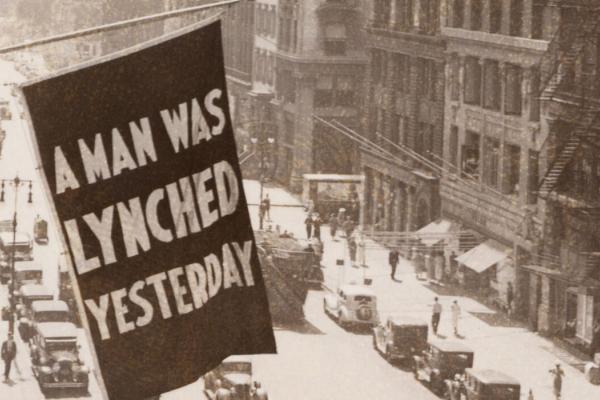THEY CAME TO the front and waited to speak with me. They were weeping.
The day before, I sat in the front seat of a packed car. Five beautiful black women, including one of the women now in tears, rolled toward Marion, Ind.—the site of the last public lynching in the North.
On the sweltering summer night of Aug. 7, 1930, three African-American teenagers—Thomas Shipp, Abram Smith, and James Cameron—sat huddled in their jail cells in Marion. Thousands of white men, women, and children gathered outside the jailhouse, screaming and jeering—demanding blood. The three were charged with the ultimate sin against whiteness—killing a white man and raping a white woman. They were dragged from the jailhouse, beaten, and strung up on a low-hanging tree branch a block away on the courthouse square, in the center of town. For some reason, Cameron was spared. The other two were not.
The town photographer captured the moment: The mob congregated like lions around mangled prey. Lips licked, satisfied grins splayed across the faces of young women and old women, young men and old men. Floral dresses, white shirts with buckled pants, and hats atop straight-backed heads covered bursting egos as they reveled in victory. One man pointed to their ritual sacrifice, and that moment became an iconic illustration of American lynching.
Five black women walked that land 87 years later. We walked the land where the jailhouse used to stand. Now apartments and condos rise up where young black boys sat shuddering in a jail cell. A million rainfalls have washed away the blood that once dotted this grass and ground. But the blood is not gone. It is underground, mixed with the earth and mulch; it bears witness from below.
James Cameron spent four years in jail. He was eventually pardoned by then-Gov. Evan Bayh.
MONUMENTS LINE the edges of Marion’s courthouse square. They celebrate the lives and sacrifices of Marion citizens—heroes. One monument, erected one year after the lynching, commemorates David Branson, a town founder who donated funds in 1831 to establish the courthouse. On the day of the commemoration 100 years later, a water fountain stood on the spot where they had broken ground. That same fountain still stands on the square. But no monument exists to commemorate the sacrificed lives of Thomas Shipp and Abram Smith. Even the tree is gone. Yet, still, the blood cries out from underground.
The next day, after our foray to the courthouse square, I spoke about the revolutionary acts by a company of Hebrew priests exiting Babylonian rule. Confined and controlled for generations, they were told they were created to be slaves. As they left Babylon, these priests looked their oppressors in the proverbial eye and said No. They wrote down their own creation story and proclaimed at its climax: All humanity is created in the image of God! All humanity has been called by God and created with the capacity to exercise dominion—to help steward the world!
Indiana was one of the centers of the “second Klan,” the early 20th century vigilante war to maintain and secure white domination. Marion was the site of the North’s last public ritual sacrifice to the God of whiteness.
Fourteen miles from Marion, I challenged the nearly all-white Taylor University crowd to look at the neighbor sitting next to them, to see the image of God behind their eyes, to see their inherent call to steward the world. I asked them to repeat after me: “I see … the image of God … in you.”
Two black women stood before me now. Holding my hands and weeping. Ariel walked the land with me in Marion the day before. Now she said through tears, “I never saw the image of God in myself before. I looked in the eyes of the white man sitting next to me. I saw the image of God in him. Then I saw it in myself.” Tears streamed. Freedom.

Got something to say about what you're reading? We value your feedback!

